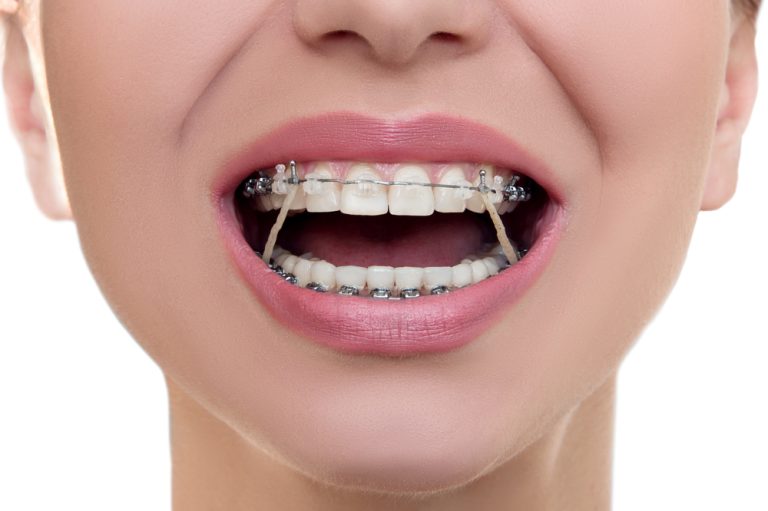Last Updated on 3 weeks by DR. ALBIN SIPES
How do braces work? It’s a question that orthodontists get asked a lot. The simple answer is that braces use brackets and wires to move teeth into the correct position.
However, there is a bit more to it than that. Each type of brace works in different ways, but they all use the same basic principles. The first thing that an orthodontist will do is take x-rays, photographs, and impressions of your teeth.
They will then use these to create a treatment plan for you. This plan will map out where your teeth need to go and what kind of movement needs to happen.
Braces are one of the most common orthodontic treatments used to straighten teeth. They consist of metal brackets that are glued to the front of your teeth and connected by a wire. The wire is then tightened or loosened to move your teeth into the desired position.
How do braces actually work? By applying pressure to your teeth, they move them into the correct position over time. Depending on the severity of your misalignment, this process can take anywhere from a few months to a couple of years.
In addition to traditional metal braces, there are also clear braces and Damon braces, which use different materials and methods to achieve similar results. No matter what type of braces you choose, you can be sure that they will help you achieve a straighter, more beautiful smile!
How Painful Is It to Get Braces On?
Most people report that getting braces is not a painful experience. But, you may feel some discomfort for the first few days after your braces are placed. It’s because your teeth and gums are adjusting to the new hardware.
You may also experience some soreness in your jaw from moving your teeth into their new positions. If you do have any pain or discomfort, it should be mild and manageable with over-the-counter pain medication like ibuprofen. If you find that the pain is more severe or lasts for more than a few days, contact your orthodontist to see if there is anything they can do to help alleviate your discomfort.
Do Braces Move Your Teeth Everyday?
If you have braces, you may be wondering if they are working to move your teeth each day. The answer is yes and no. While it is true that braces apply pressure to your teeth, which gradually moves them into the correct position, this process happens slowly over time.
You won’t see drastic changes happening on a daily basis but rather a slow and steady shift that occurs over several weeks or months. So, while your braces may not be moving your teeth every single day, they are definitely doing their job in correcting your smile! Be patient, and soon enough, you’ll have the beautiful straight teeth you’ve always wanted.
How fast Do Teeth Move With Braces?
It’s common for patients to ask how fast their teeth will move with braces. The answer varies from person to person and is dependent on a number of factors. Here, we’ll explore some of the things that can impact how fast your teeth move with braces.
Tooth movement is determined by the amount of force applied to the tooth and the length of time over which that force is applied. The type of braces you have (traditional metal braces or clear aligners) will also play a role in how fast your teeth move. Metal braces use brackets and wires to apply pressure to your teeth, while clear aligners work by gradually moving your teeth into place with gentle pressure.
Generally speaking, metal braces tend to be more effective at moving teeth than clear aligners. It’s because they can apply more force to your teeth over a shorter period. However, clear aligners are still effective; it means that they may take longer to achieve the same results as metal braces.
There are a few other things that can impact how fast your teeth move with braces: Your age: Younger patients tend to see faster results than older patients because their bones are still growing and their teeth are easier to move. The alignment of your bite: Patients who have severe misalignments (such as an underbite or crossbite) may see slower results because their bites need more complex movements.
The density of your bones: People with denser bones may find it takes longer for their tooth movement to take effect because the bone surrounding their teeth is harder to change shape.
How Do Braces Know Where to Move Teeth?
It’s a common question that patients ask their orthodontists – how do braces know where to move teeth? The answer is actually quite simple. During your initial consultation, your orthodontist will take x-rays, photos, and impressions of your teeth in order to create a detailed treatment plan.
This plan will map out exactly where your braces need to apply pressure to move your teeth into the correct position. So, how do the braces themselves know where to use this pressure? Each bracket is attached to the wire with a tiny elastic band called a ligature.
The wire runs through all of the brackets and is what applies the pressure to move the teeth. As you can see, it’s all exact and specific!
How Do Braces Actually Work?
How Do Braces Work for Crowded Teeth
If you have crowded teeth, you may be wondering how braces work to correct the issue. Plus, braces put pressure on your teeth to gradually move them into the correct position. This process can take some time, but eventually, your teeth will be straightened out and look great!
Different types of braces can be used for crowded teeth. Traditional metal braces are one option, but there are also clear or ceramic braces that are less visible. Your orthodontist will help you choose the best type of braces for your individual needs.
The process of getting braces starts with a consultation with an orthodontist. During this appointment, they will assess your crowding and determine the best course of treatment. If they recommend braces, they will then take impressions of your teeth to create custom-fitted brackets.
Once your brackets have been made, you will need to return them to the orthodontist so they can attach them to your teeth. They will then tighten the wires and make any necessary adjustments. You will likely need to return for regular appointments so that they can continue adjusting your wires and making sure everything is proceeding as planned.
It takes around 12-18 months for treatment with braces to be completed. Afterward, you may need to wear a retainer in order to keep your new straightened teeth in place!
How Do Braces Work for Crooked Teeth
If your teeth are crooked, you may be considering braces to help straighten them. But how do braces work? And will they be effective in fixing your specific dental issue?
Braces are most used to correct misalignment of the teeth or jaws. They apply gentle pressure over time to slowly move teeth into their proper position. Depending on the severity of your case, treatment can take anywhere from a few months to several years.
Different types of braces can be used to correct crooked teeth. Traditional metal braces are the most common, but clear plastic or ceramic braces are also available for a more subtle look. Invisalign is another popular option that uses clear aligners instead of brackets and wires.
No matter what type of braces you choose, they all work by applying pressure to the teeth in order to move them into place. The amount of force needed will vary depending on how crooked your teeth are. With regular adjustments, your orthodontist will gradually move your teeth closer and closer to their desired position.
If you’re considering braces for Crooked Teeth, talk to your orthodontist about which type would be best for you and what you can expect during treatment.
How Do Braces Work Overbite
Most people with an overbite have what is called a “class II” malocclusion, which means that the upper teeth project out further than the lower teeth. It can be due to genetics, bad habits (like thumb-sucking), or even injury. Whatever the cause, an overbite can lead to a number of problems, including difficulty chewing and speaking, as well as pain in the jaw joint.
The good news is that braces can correct an overbite! By applying pressure to the teeth and jaw, braces gradually move them into their proper position. Depending on the severity of your overbite, you may need to wear braces for 12 months to 3 years.
In some cases, surgery may also be required to correct an overbite. But don’t worry – most people who get braces end up with a straighter smile that they love!
How Do Braces Stick to Teeth
It’s no secret that braces can be pretty uncomfortable. After all, they are constantly rubbing against your cheeks and gums. But have you ever wondered how braces actually stay on your teeth?
It’s fantastic when you think about it! There are actually two different ways that braces can stick to teeth. The first is with brackets.
Brackets are small metal squares that are glued to each tooth. They have a tiny hole in the center where a wire is threaded through. The wire is what holds everything together and keeps the teeth in alignment.
The other way that braces stick to teeth is with bands. Bands are like rings that go around each tooth. They are made of metal or rubber, and they also have a tiny hole in the center for a wire to thread through.
Bands are usually used on back teeth because they provide more support than brackets do. So, how do the brackets and bands stay on your teeth? It’s all thanks to dental adhesive!
This sticky substance is applied to both the brackets and bands before they are placed on your teeth. Once they’re stuck on, they’re not going anywhere until your orthodontist removes them!
When Do Teeth Start to Straighten With Braces
Most people assume that teeth start to straighten as soon as braces are put on. However, this is only sometimes the case. It can take weeks or even months for teeth to start moving into their new, correct positions.
The reason for this is that it takes time for the roots of the teeth to adjust to the new pressure being placed on them. Once the roots have changed, the teeth will start to move into place slowly. Depending on how crooked a person’s teeth are, it can take anywhere from six months to two years for them to be completely straightened.
Do Braces Hurt
If you’re considering braces, one of your top questions is likely, “Do braces hurt?” The answer is that, yes, braces can cause some discomfort when you first get them. However, this is usually only temporary as your mouth adjusts to the new hardware.
There are a few things you can do to lower the pain of getting braces, which we’ll discuss below. When you first get your braces, they will be tightened. This process can cause some soreness in your gums and teeth.
Over-the-counter pain relievers like ibuprofen can help ease this discomfort. Eating soft foods for a few days after getting braces can also help reduce any inflammation or soreness in your mouth. Some people also find that their lips are irritated by the brackets on their teeth.
You can apply lip balm or Vaseline to soothe this problem. If the irritation persists, talk to your orthodontist about getting special wax to put on your brackets. In general, the pain associated with getting braces is mild and manageable with over-the-counter medication.
It should go away after a few days as you adjust to wearing them.
Conclusion
Braces are one of the most common treatments for misaligned teeth. They work by using gentle, consistent pressure to move your teeth into their proper position. Depending on the severity of your case, you may need to wear braces for a few months to a few years.
The first step in getting braces is to consult with an orthodontist, who will assess your individual needs and develop a treatment plan. Once you’ve decided to go ahead with braces, the next step is to have an appointment where brackets and wires will be attached to your teeth. These will serve as the foundation for moving your teeth over time.
You’ll need to visit your orthodontist every few weeks so they can make adjustments to the wires and brackets and check on how your treatment is progressing. And finally, once your treatment is complete, you’ll need to wear a retainer at night to keep your newly straightened smile in place!



